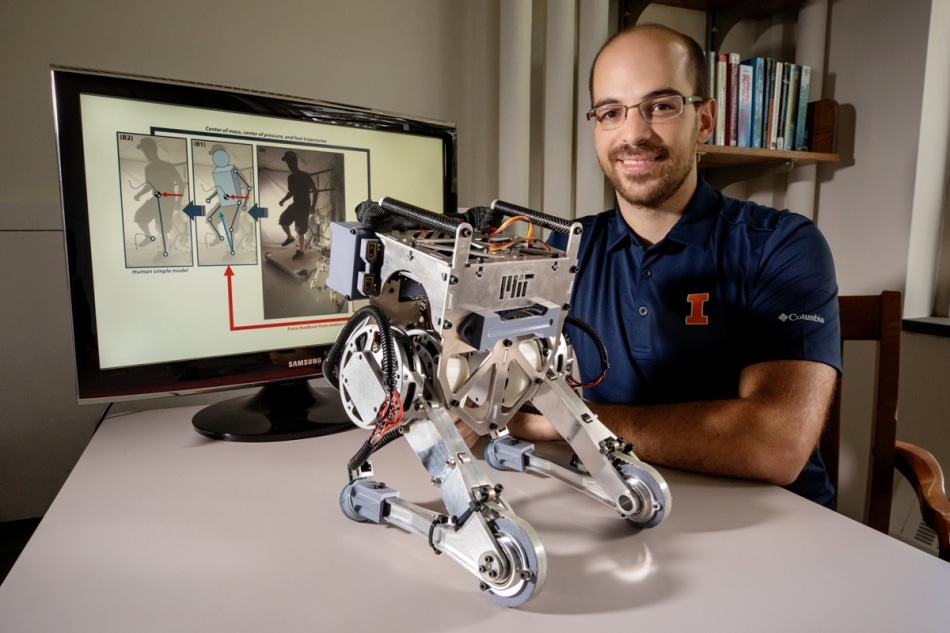Oct 31 2019
What if a person stuck inside a collapsed building following a disaster—wondering whether someone brave enough will come to rescue—suddenly finds a robot standing in the shadows as soon as a door bursts open?
 Mechanical science and engineering professor João Ramos developed a human-operated robot, named Little Hermes, which relies on human reflexes to remain upright during locomotion. (Image credit: L. Brian Stauffer)
Mechanical science and engineering professor João Ramos developed a human-operated robot, named Little Hermes, which relies on human reflexes to remain upright during locomotion. (Image credit: L. Brian Stauffer)
However, this is not just a normal robot. It has very fast, human-like reflexes and is steered by a person from a remote location who experiences the same physical forces felt by the robot.
Engineers at the University of Illinois and the Massachusetts Institute of Technology have become one step closer to human-guided robotics by developing a two-legged unit, termed Little Hermes, with the ability to walk, jump, run, and interact with the surroundings in synchrony with a human operator.
João Ramos, a mechanical science and engineering professor from the University of Illinois and former MIT researcher, worked together with professor Sangbae Kim at MIT to create Little Hermes, a small-scale bipedal robot engineered to reach places considered dangerous for humans. The study outcomes have been reported in the Science Robotics journal.
We were motivated by watching the 2011 Tohoku, Japan, earthquake, tsunami and subsequent Fukushima Dai-ichi nuclear plant disaster unfold. We thought that if a robot could have entered the power plant after the disaster, things could have ended differently. This incident was a wake-up call for the robotics community.
João Ramos, Professor of Mechanical Science and Engineering, University of Illinois
Ramos added that a major part of the ongoing research on human-operated robotics does not include any force-feedback information to the operator. According to him, if human-assisted robots were to interact with the surroundings similar to humans, the operators will have to experience the same forces that the robot “feels.”
The researchers created a motion-capture suit, similar to an exoskeleton worn by a human operator, stated Ramos. The suit picks up the motion of the operator and the forces exerted by the operator on the environment to move. It then conveys that data to the robot, which replicates the motion with little to no delay.
But robots lack an intrinsic sense of balance that a person has. Therefore, the team fit the operator with a vest that transfers force-feedback information from the robot to the operator.
If the robot begins to fall, the operator feels a push in that direction through the vest. Naturally, the operator’s reaction is to take a step to balance themselves, and the robot does the same, synchronously, preventing it from tipping over.
João Ramos, Professor of Mechanical Science and Engineering, University of Illinois
He added that the majority of robotics research pays attention to creating completely automated units. “I believe that we will achieve fully autonomous robotics at some point, but that is still pretty far in the future. It is advantageous to continue work with human-operated robotics rather than putting all of our efforts into programming fully autonomous robot technology. This way, humans still maintain a considerable level of control.”
According to the team, Little Hermes could be advanced in several different ways. For example, the teleoperation between the operator and the robot takes place by means of a wired side-by-side interface. However, the team intends to use wireless technology, analogous to the one used to manipulate drones.
We also plan to develop robot-to-human force-feedback devices to other parts of the body like the feet and hands. Additionally, everything we have developed so far is not constrained to bipedal robots; any of the technology transfers easily to other mobile systems like quadrupedal and wheeled robots.
João Ramos, Professor of Mechanical Science and Engineering, University of Illinois
This study was supported by Hon Hai Precision Industry Co. Ltd. and Naver Labs Corporation.
Dynamic locomotion synchronization via bilateral feedback teleoperation
Video credit: University of Illinois.